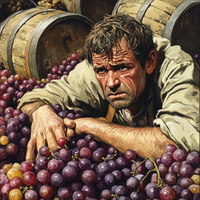How to Avoid Stuck Fermentation
Posted by Matteo Lahm on 22nd Jan 2025
Stuck fermentation is a common issue in the world of brewing and winemaking, but it's one that can and should be avoided with the right knowledge and techniques. This article will guide you through the causes of stuck fermentation and provide you with practical steps to prevent it from happening. The three pillars of a successful ferment are proper preparation of your batch, the right environmental conditions and healthy yeast. While there are methods to restart fermentation, it far better to make sure you won't ever have to do it.
The first step in avoiding stuck fermentation is ensuring that your yeast is fresh and has been stored correctly. Yeast, like all living organisms, will eventually decline. We are not the same people at 70 as we were at 25. As yeast ages, more and more cells die off. Starting with a low number of yeast cells will inevitably lead to a low count when you need them most. During peak fermentation, yeast populations double approximately every 20 minutes. Therefore, starting with a small population will result in a small final count, and a low yeast count is a surefire way to encounter issues. High yeast populations are particularly crucial towards the end of fermentation, where stuck fermentation is most likely to occur. As the alcohol content increases, yeast activity decreases due to the toxic effect of alcohol. The higher the alcohol content, the more yeast cells you need. Given the affordability of yeast, it's not worth risking your batch to save a few dollars. If you do, you could end up costing yourself a lot more in lost ingredients and time.
One effective way to ensure a high yeast population is by using a yeast starter. This allows your yeast to multiply before inoculation, providing a larger starting population. It's also important to remember that yeast doesn't like competition. Fresh fruit, for example, is covered in wild yeast strains that will compete for dominance, potentially causing your yeast to fizzle out or produce unpleasant flavors and aromas. If you're using cultured yeast with fresh fruit, it's best to purge with 1/4 tsp of sulfites per 6 gallons of must 24 hours before pitching your yeast. Cultured yeast is formulated to be sulfite resistant, so purging your batch of wild yeast and introducing a healthy population is a wise move.
Next, it's crucial to understand the temperature requirements and alcohol tolerance of your yeast. If you're fermenting in a warm environment without temperature control, you'll need a yeast with a high heat threshold. The same principle applies in colder environments. As for your sugars, taking hydrometer readings and verifying your eventual ABV (Alcohol By Volume) are key. If your yeast can't exceed 13% ABV and you have enough sugar for 17%, stuck fermentation is almost certain. The result will be a sweet wort or must with sulfuric flavors and aromas. Yeast produces hydrogen sulfide gas when stressed and the closer they get to that threshold, the more stress they have.
Excessive sugar isn't the only risk. Improper pH can also cause stuck fermentation. Wine yeast ferments best between a 3.3 and 3.6 pH. Beer, however, can range from a 3.0 to a 5.5 pH depending on the style, so choosing the right yeast is essential. There are many more types of beer yeasts than wine yeasts for this reason. For instance, you wouldn't use the same strain for a stout as you would for a pilsner or a blonde ale. Generally, pH adjustments aren't necessary for beer as long as you're following the recipe and style guidelines. Fruit, however, is more variable, so it's crucial to test and adjust your acidity before pitching your yeast. Any given fruit can vary a full pH point. That might not sound like a lot but it is. A 3.0 is ten times more acidic than a 4.0 and 100 times more than a 5.0.
Still, yeast needs more than just sugar and the right pH to thrive. It also requires nutrients. Some yeasts have high nitrogen and supplemental requirements, so adding nutrient can help your yeast achieve a clean ferment. Nutrient becomes especially important if your final ABV will be near the yeast alcohol threshold. If you are fermenting a red wine with RC-212 that will reach 14% ABV, that is close to the maximum ABV for that yeast. The nutrient will keep your yeast healthy as it trudges to the finish line. Fermentation starts with a sprint and ends with a limp. Nutrient can help your yeast not trip along the way.
Finally, when you pitch your yeast, don't initially stir your wort or your must. Yeast cells prefer to clump together. Let them spread through your batch on their own. Whether you are dry pitching or adding a starter, not stirring helps them to form their own networks more quickly. They function better in higher concentrations. It also ensures you will not shock your yeast if you are using starters. If your wort or must has a significant difference in temperature and/or pH, the abrupt change could cause stress. Allowing them to assimilate and spread through their environment on their own facilitates more replication and cleaner fermentation. It is best to wait to stir when fermentation is well underway.
By following these guidelines, you'll be well on your way to avoiding stuck fermentation and producing a successful batch of beer or wine. Yeasts are formulated for specific beer and wine styles. They have specific nutrition requirements, alcohol thresholds and temperature parameters. If you use the right yeast and give it what it needs, it will not stall. While there are ways to restart fermentation, you won't need to with proper procedure, preparation and healthy yeast. Good luck!

